Member Exclusive, Modern Marketing
Marketing Briefing: The future of NFTs in loyalty programs
- Starbucks has been getting a lot of attention for its moves surrounding NFTs.
- Will NFTs find their home in loyalty programs?








